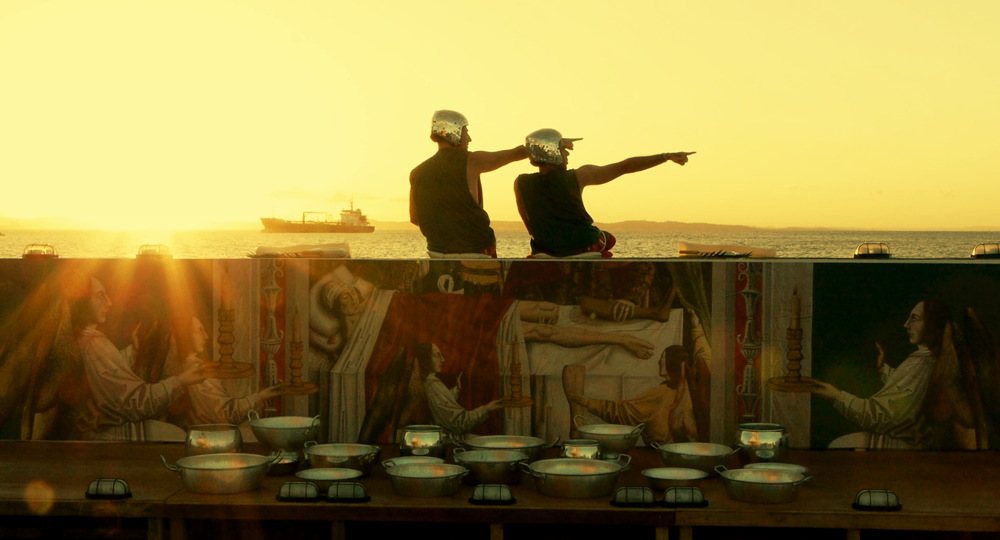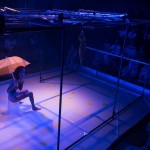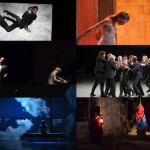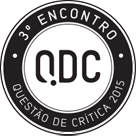Notes along the Way: FIAC 2015
Critique of the 2015 edition of the International Festival of Scenic Arts, Bahia, Brazil
Vol. IX, nº 67 abril de 2016 :: Download complete edition in PDF
By Mariana Barcelos and Renan Ji
Translated by Leslie Damasceno
Abstract: Considerations regarding the curatorial thought behind FIAC, Bahia’s international festival of theater arts and performance. This article analyzes works presented at the 2015 edition through a series of five horizontal concepts: cartography, body, musicality, the corpus of local (Bahian) plays and the spectator. These categories represent different and independent ways of looking at the festival’s program, without exhausting other possibilities of critical thinking about the works assembled.
Published in Portuguese in December, 2015 at Questão de Crítica. Available at: Available with images at: http://www.questaodecritica.com.br/2015/12/fiac/
Keywords: FIAC Bahia 2015, cartography, body, musicalities, spectator
During the ten intense days of the Festival Internacional de Artes Cênicas da Bahia (International Festival Scenic Arts, Bahia) – FIAC 2015, we saw eighteen works of from five Brazilian states – Bahia, São Paulo, Rio de Janeiro, Paraná and the Federal District (Brasilia) – as well as four other pieces from other countries – France, Spain, Belgium and Italy. The amount of works, added to their geographical range, presented challenges to writing and editing this article from the beginning.
With the printed program of the Festival in front of us, we circled events with a pen, trying to encompass all programming, and establish the routine of our next few days. Even so, there were two works we could not manage to see – Biomashup (Cristian Duarte, São Paulo) due to overlapping schedules, and Clean Room – 2nd Season (Juan Dominguez, Spain), for reasons that will be explained later.
At the end of the first days, we made notes of all works seen in sequence of the past hours. Everything seemed too different to try to force any written analysis at that moment. Also happening this year: the 2nd edition of the International Seminar for Curators and Mediation in Performing Arts, which, as part of the festival program, gathered together artists to dialogue (“direct and informal conversations with the public”) about experiences in their creative processes. Although most of the talks did not refer to curatorship (which was the announced proposal of the seminar), it was from this idea that we began to develop our analysis of the events.
For the first time we were at a festival without having the task of writing a review for each performance directly as we saw them: the article would come at the end of the whole event. We thought this an important starting point to clarify our work. What are the differences between writing a review, or critique, for a specific performance or work and preparing a text about a festival? The answer is already embedded in the question, repeated here for emphasis: this article is about the festival, not on the works alone. Being able to go through the FIAC in its entirety allowed us to look at the FIAC itself, and therefore take it as an object in our analysis.
It is difficult to talk about the 2015 edition from the perspective of the uniqueness of an annual event. In conversation with Felipe de Assis, who acted as the general curator of the event along with Ricardo Libório, we saw that the FIAC comes from, and is linked to, a continual work of research, dialogue and training which involves a whole community of people, who assume various positions of engagement, united in the desire for proximity to the arts, more specifically with the performing arts.
Felipe de Assis outlined an intricate network that forms from workshops of various kinds, training projects for teachers, pedagogical advice, activities to increase enjoyment of the performances and knowledge of cultural facilities: in short practices that dilute somewhat the idea of an artistic community as an organism apart from the general public. The FIAC, thus, emerges as the crowning product of a whole work that extends over years, bringing together people not merely as participants in the festival, but to a greater or lesser extent, active agents in its preparation and execution.
That said, we return to the curatorship. Felipe de Assis explains that his curatorial thinking involves the idea of ”non-curatorship,” as opposed to the valued place of the “curator-author.” He thinks of the curatorship as an activating agent for the event, not in terms of a pre-shaped reading. The festival is not a museum exhibit and in view of this, the idea is to create an environment for the exchange of experiences with the public. De Assis thinks, above all, of the festival’s role within the city and how it can achieve its geography in different urban sites, from the center to the periphery, symbolic and material.
Thus, addressing the themes and possible profiles of FIAC 2015 is not so much to speak of specific choices and issues of the Festival, as designed by the curators, but to follow the developments of a workflow that is already in its eighth year. Symptomatically, de Assis tells us that the concept of mediation, which amply encompass the activities mentioned that culminate in the FIAC, provides what he calls “activating environments”: issues and dialogues involving artistic concepts and/or personal relationships, which will gradually be incorporated into the festival. Thus, the traditional sense of curatorial work unravels to cover subjective and circumstantial factors, such as emotional and professional contacts between artists and organizers, to the same extent that it channels a diffused (but powerful) guideline to perceive alterities and revitalizations in the urban cultural landscape.
In this perspective, “post-festival” readings become important since each edition of FIAC occurs almost like a living organism, assuming various configurations according to the constant movements of the nuclei involved. We start form this premise of an environment that activates dialogues, and to observe our own experience as a public, we have identified five possible concepts that run through the festival programming and use them as axes for this article. They are: cartography, body, musicality, Bahian plays and spectator. These cuts, or editorial emphases, constitute our manner of entering into the dialogue, representing one more of several possible assemblages in this network of filmmakers, artists, critics and spectators.
Note: The following sections have been elaborated as small cores that cover certain sets of parts and propose a question that concerns them in order to facilitate independent reading of the sections. A continuous reading to go through all these points at once may find some repeated data, but the reader will surely see that they too can often complement each other.
How to (re) learn a space
The presentations took place in eight theater buildings; spaces on the street that went from avenues to viaducts; a mansion in the historic district of the Pelourinho; the space of one of the theater companies; and an unknown place, to which we had no access. The visual identity of the programming resemble a map from afar, and up close it traces lines that cross over to coordinate the flow of activities. In ten days, it created an intense process of intimacy with the local geography.
Cartography was clearly a theme of the programming, but beyond the geographical materiality, it also appears as an object of some of the plays. In this section we will mention the works in which this theme appears, and how reflections about spatial alignment during the performances indirectly came to the fore. Starting with the binomial inside/outside: no matter where, the stage is everywhere. Many of the presentations took place in external locations, and by no means were called street theater. The first thought about space brings the symbolism of erasing the boundaries of adjectives.
Next, we have a way to relate to this space, which identifies another dialectical relationship: the known/local, the sense of belonging that Bahian plays transmitted; and foreignness, the strangeness felt by someone who transits in that space for the first time. Geography is inseparable from linking the two, where the two scenarios were determining: the native and the foreigner, understanding feelings of foreigness to also extent to people from other cities within Brazil.
The remarkable work of Castelo da Torre (The Castle Tower: Vilavox, Bahia), for example, staged at Solar (Mansion) St. Damasus, in Pelourinho, makes a historical link with the architecture of the seventeenth century. By bringing narratives about the violent and shameful treatment of slaves by the members of the Garcia d’Ávila family, the production provokes a sense of confinement in the past and at the same time promotes fissures to think about slavery reminiscences in the present. Since the narrators and characters are dead, ghosts of the house, O Castelo da Torre constructs a historical maze through the architectural structure of a painful period. Geography marks temporality and in this sense, one cannot disentangle from the local history of the buildings. The large house, the Pelourinho[1], the stone streets, all give form to a cartography that is not presented solely in a horizontal visual dimension, but also vertical, historic. Cartography is time.
Another experience that articulates history and architecture is the production A Bunda de Simone (Simone’s ass: Teatro Base, BA). Called the Barroquinha Cultural Space, the theater has the shape of a corridor and is located in a very old church tower. The theme of the play, which deals with sexual freedom, women’s freedom, the rediscovery of the body without sin, not sacrilegious, confronts the symbology of the building itself. The actors act naked, bathed in water of the stage set, which is a rectangle with a floor covered by a canvas, and above, ridges formed by hydraulic piping that form vertical and horizontal streaks (a map). Small registers can be triggered and water comes down from all the pipes, like rain. “You have to wash the body,” a recurring phrase in the show, alluding to baptism, but a new, liberating one. The architecture’s condition as a place of reverence – given its historical characteristics – is thus challenged. There is no passivity in the face of cartography.
From the trip to the past of colonial captaincy to mapping the current neihborhood of Politeama, in central Salvador and in apparent decay, Ruína de Anjos (Ruins of Angels: A outra cia. de teatro, Bahia) brings to the neighborhood streets characters we call “cartographic” characters that would be recognized in the streets of any neighborhood with the same characteristics. There is the pastor who preaches in public spaces, a traffic signal juggler, an old homeless lady with her cart, unrecognizable under the piles of rags, the informal street vendor in a wheelchair selling coffee and the young man who likes to fight and has a hidden relationship with a transvestite. At night, walking through the streets, the scenario takes place in the live time of the characters, leaving the company’s headquarters and returning to the same place an hour later. The play presents a stronger notion of mapping, determining a kind of floor plan in which the characters dialogue with the spaces that would be those of their daily life experiences. The transvestite dreams of marriage by choosing a short, shiny wedding in the window of a street gallery shop, but later takes a beating from her boyfriend at the church door. The juggler says he has been cheated by a businessman who promised him a job at the door of a company known for promoting cultural projects. In a flashback, the wheelchair-bound boy reveals that his dream was to be a football player, but one day playing ball in traffic signal intervals, he took a stray bullet. Geographic mapping occurs together, therefore, with human mapping. The streets and the people that transit in them are not separable.
Ruína de Anjos also points to the side of the street that is usually not seen, it points to invisibilities. The street as a place of passage and not assimilation. In this perspective, there are another three works that practically force us to look at what is “outside.” Galeria Urbana Homo sem Cabeça (Urban Gallery Headless Homo: Lucas Valentim, Lucas Moreira and Isabela Silveira, Bahia) invests in shock interventions. At the exit of the Teodoro Sampaio tunnel and the São Raimundo Overpass, artists occupied and moved through space with clothing out of context (chains, masks that hid the head, words written on the body, etc.), with the intention to shock those who can only see in these spaces an access road into seeing the space differently. Cosme e Damião/Duo (Cosme and Damian/Duo: Gilles Pastor, France), presented at the Passeio Público (Public Garden-Park), directs and holds attention to the surroundings through another resource: contemplation. Purposely designed to be staged at sunset on the Passeio overlook, the symmetrical images produced by the two actors, against the light, create an ideal environment for appreciation, pause – the act of observing and noticing.
Joining two points of the city, História sob Rocha (History under Rock: Daniel Guerra, Bahia) is the product of an immersion process that artists carried out in the peripheral and underprivileged neighborhood of Cajazeiras. Living for months in a neighborhood residence, the productive and creative center of the work had moved to the usually ignored urban periphery. Activities and actions emerged from this time of “living together” – inter-crossings between the artists from the urban center and the distant population. The movement is toward alterity, and it takes place as what they call a “scenic event.” A multitude of objects of Cajazeiras residents are arranged on the floor of the Praça Municipal (Municipal Square), with which the public should, in its own way, weave “live” interactions. These are objects endowed with memory and geography, but they become resignified with new users while at the same time converging distant points of the map of the city – and the world. As in the case of the black boy who, wrapped in a leopard print blanket and wearing a carnival crown, became the “king” among the children and led the chorus, by microphone, in a song to Iemanjá.
One sees abandonment and the abandoned, but also the beautiful. The aesthetic elements mentioned in the cartography not only relate to denounce neglect, they exist, before all, as the first attempt to say “look at this here.” This is crucial to the native perception, where you have to make an effort to be able to see what is familiar, but it also should allow itself to be charmed by the quality of a foreign regard. The natives speak authoritatively about the places they belong to, the foreigner, in astonishment.
Orgia ou de como os corpos podem substituir as ideias (Orgy or how bodies can replace ideas: Kunyn Theatre, São Paulo) captures the essence of the foreign look. The play takes place in three areas, the first in a common house chosen by the artists days before the presentation in the center of Salvador, in which the Argentine protagonist of the play enacts intimate moments of familiarity with his “friends” (the public) days before going on a trip to another country – the dislocation here is also fictional. Upon taking leave of his wife and putting his bag on his back, the three actors (who do the same character), divide the public who accompany them through the streets of leaving home to get to the Largo do Campo Grande. The public, who has earphones connected to a mp3 player activated by the production, then receives the instruction to press play. The character walks across the square, his thoughts about getting to another country – namely Brazil, more specifically, Recife – heard by phone. Everything is disorientation, bewilderment, wandering, and the realization that this place full of history, was for him, a blank without memory. The space is public, impersonal and without affect. It offers the chance to open the mapping from scratch.
The foreigner has to remember that cartography is not exhausted in the remains of the past. The last space in the room in the Goethe Institute, represents the period of confinement and torture that the character endured. A very small place and with poor visibility at the beginning due to smoke. The performance’s present cartography permeates the dramaturgy and staging – from Argentina to Brazil; house, street, Largo to study hall of the Institute. The character leaves the intimacy of his family and goes to another end, when he becomes an unknown person tortured by mistake. The cartography marks the bodies of the subjects, the tracks of the native are different from those of the stranger – but they can free him from the mistake of being confused.
Cosme, the central character of Caranguejo Overdrive (Crab Overdrive: Aquela cia. de teatro, Rio de Janeiro) lives a conflict regarding his geographical identity. Called up and enlisted to participate in the Paraguayan War (1864-1870), on his return to Rio de Janeiro, his homeland, he no longer recognizes the geography of the city after the grandiose urban works that began during his absence filled in the swamp where he worked. He becomes a native and a foreigner at the same time, a condition of no return. The cartography of this production is radically its object. The remodeling of the city ignores the individual as its main component, and in order for him to not feel even more lost, ironically it is an Paraguayan immigrant who recounts the entire history of Rio and the country up until now to Cosme. On a map, like those found in schools, a crab moves with difficulty, without his mangrove swamp and therefore homeless, denouncing how politics influence and modify the urban cartography without understanding it as a body, but merely as concrete forms that generate money, ignoring natives (and foreigners).
The cartography also has its blind spots. It is part of geography to not know the exact direction to follow. An emblematic production of the festival, Clean Room – 2nd Season (Juan Dominguez, Spain), presented in three days six episodes of an experience that could not be seen by anyone but the participants who started the process weeks before the FIAC. The presentations were announced in the program with time and date, but without the locale (only participants received this information by email). Confidential to few and unavailable for the rest. Some addresses will never be found.
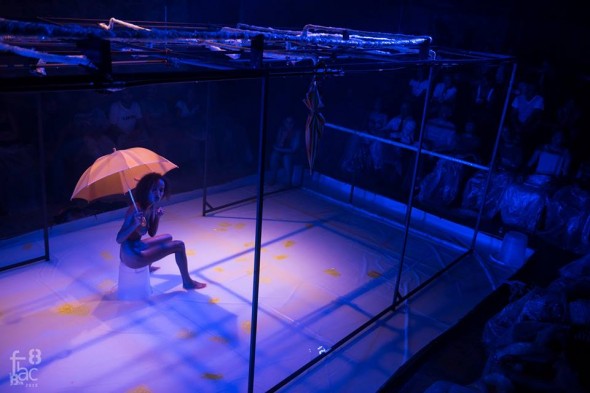
What can a body do?
Onstage, the body is dismembered and remade. Gets naked and then immediately re-clothes itself, a kind of transvestite operation. However, the evolution of the body takes on new possibilities when one perceives that other bodies (viewers, for example) are present, and that the space establishes tensions with the body in action. The FIAC brought to Salvador a series of performances that reflect on these new corporal configurations: whether it is the convolution of the body that unfolds new organic forms; whether it is how the body propels itself toward other bodies and other spaces that welcome, accept or repel it.
Initially, we are talking about works that demand attention to and contemplation of the actor’s technique, as they show us the solid achievements that the corporal arts have exhibited throughout the twentieth century. Although there may be no tendency to virtuosity in shows like Mundomudo (Mute World: Companhia Azul Celeste, São Paulo(), Cosme e Damião/Duo (Gilles Pastor, France) and nil – nada novo sob o sol (nil – nothing new under the sun: Neemias Santana, Bahia), it is clear that we are faced with practices that recognize the power of a historical legacy, actualizing it. For example, in Mundomudo, one sees a tradition of performing arts that calls for the spectator to look long and closely at physiognomical traits and at the fine execution of gestures and routines in the sensitive and meticulous exercise of clown techniques, which reverberates with an atmospheric immersion experience that is somewhat Beckettian. On the other hand, the performance Cosme e Damião/Duo activates sound and landscaping effects as a way to create a space conducive to the practice of two actors, who echo the theme of the double underlying the figures of these saints celebrated in popular religiosity. In this sense, the formal procedures managed by Gilles Pastor – moreover, formative traits of the performance tradition that emerges from the 1960s – can be seen in conjunction with the movements of the piece nil: a performance that modifies our expectations with the caption “nothing new under the sun,” which presents us with an exercise of scenic elaboration around a quasi-vocabulary of contemporary dance movements.
If the shows mentioned above require a focused awareness to corporal work whose recognizable procedures make us pay attention to training and technique, it is equally certain that the FIAC also turned its attention to attempts to perform a kind of deconstruction of these same procedures and techniques veering toward either an excess of mise-en-scène, now towards a disintegration of it. We speak specifically, in the first case of Um corpo que causa (A Body that Causes: Jorge Alencar, Bahia), a concept spectacle of creation and “causation” (as per the program). In it, the inter-crossings, or “travestivizing” of operations and melodramatic staging of personal fantasies add layers and layers to the scene, intensifying the theatricality and skidding toward a camp and drag aesthetic. At the other end of this strategy, Hamlet, processo de revelação (Hamlet, a Process of Revelation: Coletivo Irmãos Guimarães, Brasilia) relies on a rarefication of the traditional actor’s technique of narrating Shakespeare’s tragedy. Emanuel Aragon, the actor who also wrote the script, tries a (but not professorial) didactic approach to the traditional English text, seeking to reveal its singularity by way of a corporal openness to conversation and discussion with the public.
It is interesting to note that the extremes, in the actor’s activity, of travestism and denudation are not always irreconcilable. The conciliation would occur, for example, in cases in which the actor’s creative process becomes the actual subject matter of a performance. Accordingly, the reduction of the scene to corporal or training exercises would provide a margin to a deep dilution of theatricality, which gains, however, expressive layers to the extent that training entails unprecedented opportunities for experimentation. This idea becomes clearer when we see works such as Denise Stutz’s, who directs one of the six pieces that make up 6 modelos para jogar (6 Models to Play: Alex Cassal and Dani Lima, Rio de Janeiro). The production consists of a mosaic of six pieces-procedures, each conceived by different directors. Presented at FIAC this year, the Stutz work brings to the scene sequences marked by precision, as a minimalist exercise performed by the actors. The minimalism of the staging, however, gradually slides into improvisations that build new and evolving corporal images, with peculiar sounds and a total reconfiguration of the actor’s relationship with the public.
6 modelos para jogar transforms experimentation into corporal dramaturgy, a progression that characterizes many contemporary creative processes. They invest heavily in the actor’s work to reach other corporal materialization levels, reaching on stage, for example, interesting hybridizations such as those realized in Caranguejo Overdrive (Aquela cia. de teatro, Rio de Janeiro) and It’s going to get worse and worse and worse, my friend (Voetvolk, Belgium). In the first study, Marco André Nunes directs the metamorphic body of actor Matheus Macena in his becoming man-crab, as well as the psychophysical resistance of Fellipe Marques’ performance. In the same measure, the dance performance of Voetvolk company brings us Lisbeth Gruwez’s “body-horse,” an image that counterbalances and eventually overcomes the rigidity and discipline of her “military” movements as well as the hard physiognomy and physical power of her jumps.
It is important to realize that both Caranguejo… as well as It’s going to get worse … are works that hybridize physiology with biological intersections that are embedded in contexts of undeniable political criticism. Hunger and the iniquities of Rio’s urbanization process occupy the dramaturgical attention of Caranguejo… (author, Pedro Kosovski), just as Lisbeth Gruwez’s work has as its point of departure the rhetoric of political speeches, which often drift into symbolic, and even more immediate, violence. It deals with a notion of the body in tension with biopolitics (as in Michel Foucault’s thought), configuring a corporal guideline that is evidenced, to a greater or lesser extent, in many of this year’s productions.
A bunda de Simone (Simone’s Ass: Teatro Base, Bahia) is perhaps one of the FIAC works that most acutely focuses this political consciousness. The aquatic dramaturgy of the production proposes a double meaning to the act of washing the body: the neurotic asepsis of contemporary hygiene habits, concomitant to an effort to “white-wash” the discourses that superimpose on the (mainly female) body. Accordingly, the water erosion opens alternative ways of enunciation, where autobiographic texts reflect on the restrictions and constraints that the body is currently subjected to, in an attempt to strip and recover the materiality of bodies and sexuality.
The aquatic theme and its relationship with the female also appear to be the main concern of OFÉLIA: sete saltos para se afogar (OFELIA: Seven Leaps to Drown Onself: Raica Bonfim, Bahia). However, unlike the guideline to corporal presentification in A bunda de Simone, this work seems to rely on the gradual disappearance of the female body as it fades through video projections, into textures created by light, into the actress’s beautiful song, along with a succession of “leaps” (which come across as stages of scenic research regarding the image of the Shakespearean character). Raica Bonfim’s Ofelia, thus, configures a female revealed in phantasmagorical atmospheres, like a mermaid that bewitches by its song and dives into the deep waters of its own childhood reverie.
It should be emphasized that the body that loses its contours does not necessarily exhaust its materiality. That is, evanescence is not a virtualizing trace of corporal image, but a factor that tenses the body’s physical presence with its undeniable historical dimension. If the monologue about Ofelia inevitably dialogues with the historical weight of Shakespeare’s theater, we see that ghosts of the past erupt even more forcefully in works such as O Castelo da Torre (Vilavox, Bahia). Recovering an important nucleus of the colonial history of Bahia, the show seeks to give voice and body to the saga of the Garcia d’Ávila family, a family that concentrated one of the largest land holdings in Brazil during the seventeenth century. More specifically, the group Vilavox seeks to resume the narrative of the excluded from historiography, those who provided the labor force and sacrificed their bodies to build the landowner’s power: black and indigenous bodies that scenically appear as the “organic phantasmagoria” of a historical past characterized by slave labor, violent deaths and rape. Presented in the Solar São Dâmaso, a large old seventeenth century house in the historic center of Salvador, the piece builds a kind of cloister or sepulcher, turning up ditches and graves and resuscitating men and women violently buried by the narrative of the victorious. The actor’s body, in this sense, creates a strong point of tension: physical presence painfully recalls a history of massacres, but at the same time is theatrically based in today, politically questioning the present. One of the final scenes dramatizes this duality acutely: a black actress, wearing rags, walking and intoning a song-lament through the street that crosses the entrance of the Solar as we observe from the house’s windows. Her ghostly presence in that space, amid the indifference of bystanders and the police from the nearby police station, intensifies the questioning that the performance itself demands of us: “Look to the past, what do you see? Look at the present, what do you see?”
O Castelo da Torre proposes a notion of body that undeniably presupposes its spatial insertion, namely a large house in the Pelourinho that reverberates with the memory of a brutal and unjust socio-economic system. In this work, you can identify the idea of a body that interacts with several spatialities, where the physical presence of the actor and the scenic research coincide to consider the injunctions that public and/or private spaces exercise on dramaturgy.
From this perspective, we note that many of the FIAC 2015 works have to do with the relationship body and city. In this sense, Ruína de Anjos (A outra companhia de teatro, Bahia), for example, seems parallel to O Castelo da Torre. Both productions start from spaces with local historical contexts. The Vilavox group discusses the survival of archaic social structures, whereas the Ruína de Anjos sets up a dialogic intervention with a more recent history and geography: more specifically, the urbanization process (often perverse) taking place in the Politeama district where the theatre company has its headquarters. In the dramaturgy of Vinícius Lírio and Luiz Antônio Sena Jr., the theme of social invisibility dialogues with urban space relegated to marginality, in an itinerant play that travels through the neighborhood, currently undervalued on the social map of Salvador. Like a contemporary and pagan morality play the characters embody allegorical types, whose collective resonance is the product of an aesthetic amplification of the social body rooted in that neighborhood, in that community. The fictional tableaux unfold in the space of the street or in popular shopping galleries and, through these pictures, the allegorical types refer to the process of social and urban degradation happening in Politeama before our very eyes.
One of the most interesting experimentations of this year’s FIAC, corporal theatricality in tension with the public space, also becomes a determining procedure for both Galeria Urbana Homo sem Cabeça (Urban Gallery Headless Homo: Lucas Valentim, Lucas Moreira and Isabel Silveira, Bahia) and História sob Rocha (History under Rock: Daniel Guerra, Bahia). In these performative works, interaction and friction of the aesthetic body of the actor with passerby on the street or the spectator provide the basis for theatrical experiences whose duration and effect depends solely on the flows in public space, from which the theatrical game adds new spectators and potential agents/actors, triggering various degrees and forms of interaction. In Galeria urbana…, performers wearing apparel that cover their heads become bodies without metaphysics, whose physicality and costumes become estrangement factors in spaces intended exclusively for pedestrian crossing, such as the public gardens. On the other hand, in the collective performance of Daniel Guerra, the actors perform true coexistence exercises with the subjects involved, providing recreational situations, props and even the availability of actors to spontaneous interact with the audience.
Finally, among the many possibilities that the festival provided for thinking about the body in the theater, it is worth noting the complexity and diversity of Orgia (Teatro Kunyn, São Paulo). With the suggestive subtitle “of how bodies can replace ideas,” the piece is inspired by Túlio Carella’s homonymous autobiography and fits into the broad line of theatrical works in urban spaces. Carella’s diary recounts his experiences traveling to Recife, where he gives himself to furtive encounters with other men in public places. In a free adaptation from the book, the Kunyn builds a dramaturgy that aesthetically reworks this erotic universe, revealing three phases of experimentation from the actor’s body: first, the everyday bodies of Luis Gustavo Jahjah, Paulo Arcuri and Ronaldo Serruya slowly lead the viewer to Carella’s biographical plot. Then the actors undertake am ambulatory drama through the middle of the Largo do Campo Grande, Salvador, referring to feelings of clandestinity, wandering and unequivocal freedom experienced by Carella. Finally, after the “frisson of hunting” in the public park, the piece proposes an experience of confinment and despair, which scenically reworks the biographical fact of Carella in prison, arrested for being wrongly accused of subversion by the military government.
Of all of the productions we saw, Orgia ou de como os corpos podem substituir as ideias is the one that seems to illustrate most poignantly a corporal “venture,” a kind of destiny or impetus that seems, however, to be present in each of these briefly commented works. In fact, in all of them, the actor’s physical presence seems to be a significant element of the dramaturgy, indicating that the reception of the plays should really take into account the body in friction with alterity as a factor to be considered in the intellectual appreciation of a work of art. It is a matter of seeing how bodies on stage or in the street can (and should) replace ideas. Perceive and feel, finally, what a body can do.
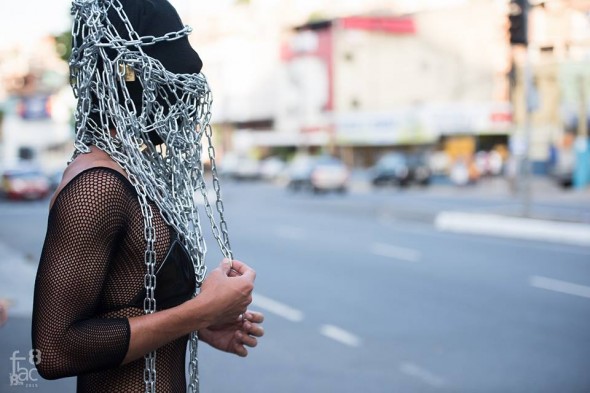
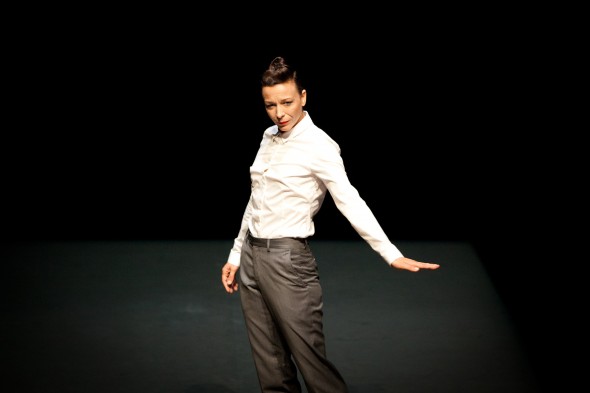
“We, for example:” to assume and appropriate the local[2]
In the dialectic between the local and the universal, the FIAC works toward a wide cultural projection comprising national and foreign productions, also assuming the mediation between circuits and local productions. In this sense, a fundamental part of “internationalizing” the proposal of the festival seems to be precisely its roots in Bahia, promoting the circulation of a diversified human capital through the geography of Salvador, and the intellectual, cultural and artistic exchange between the different agents that the event gathers together.
A fact of great interest is that FIAC 2015 counted with a special team of curators in order to cast a glance, parallel to the general curatorship, to what was happening on the local scene. For Bahian productions, therefore, Celso Júnior, Gilsamara Moura, Joceval Santana, Maiara Cerqueira, Ruy Filho and Thiago Andrade joined the general curators Felipe de Assis and Ricardo Liborio. The result of this effort can be seen in all the works that were contemplated by the festival, with particular attention to young authors and directors, as well as for dialogue with local geographies, specifically tensions with the urban environment.
Escavadores (Excavators: COOXIA – Coletivo teatral, Bahia) and nil – nada novo sob o sol (nii – nothing new under the sun: Neemias Santana, Bahia) appear to be productions that refer to a context of academic training, being developed from research derived from the School of Fine Arts and of the Theater Company of the Federal University at Bahia (Escola de Belas Artes e Companhia de teatro/UFBA) as well as the debut of a young director in an experimental project in dance, in the case of nil…. Thus, although the hopeful political and philosophical allegory Escavadores differs from nil‘s post-utopian environment and obscure dramaturgy, we find the presence of an active youth in Bahia’s theater scene in these two productions, a presence that characterizes many of Bahian performances that we will comment on next.
The monologues Um corpo que causa (A Body that Causes: Jorge Alencar, Bahia) and OFÉLIA: sete saltos para se afogar (OFELIA: seven leaps to drown oneself: Raica Bonfim, Bahia) connect the contexts of Bahian culture in different keys, but also establishing wider openings for other possible readings. Jorge Alencar’s cabaret puts together a pop, drag and camp culture patchwork, but without ceasing to take root in known strongholds of Salvador’s alternative night scene, like the night club Âncora do Marujo, which became a place dear to the local theater community. On the other hand, at times in the more intensely lyrical Raica Bonfim show the singing and the water symbolism harkens back to a theme dear to Salvador’s imaginary: the relationship with the sea. In many instances, the vocal performance of the actress even subsumes elements of the ritual chants of the orishás, performing an interesting dialogue between the tragic heroine and Iemanjá, the deity of the sea.
It is worth emphasizing the significant portion of Bahian productions that corresponds to work immediately linked to social contradictions and specific spaces of the urban topography. O Castelo da Torre (Vilavox, Bahia), for example, by plunging into the violent and shameful past of Brazilian colonization, seeks to cause tensions with historical- geographical present, as the performance takes place in the Solar São Dâmaso, an old mansion located in the Pelourinho area of the capital that intermixes tourism, nightlife and remnants of colonial history.
Following the same guiding principles, but more objectively linked to the contradictions and inequalities of Salvador’s urbanization process, História sob Rocha (History under Rock: Daniel Guerra, Bahia) and Ruína de Anjos (Ruin of Angels: A outra companhia de teatro, Bahia) are immersed in the daily life and in the communities of the Cajazeiras and Politeama neighborhoods, respectively, where the site becomes a research object and the foundation of its dramaturgy. Daniel Guerra’s work uses the living experience with residents of one of the most populated districts of the city as material for performances and installations in public facilities, composing the various scenic-experimental modules that constitute História sob Rocha. In the same fashion, A outra companhia de teatro (Ruína) also seeks to support the dramaturgy of its itinerant piece from dialogue with local people, establishing dynamics with residents and trying to understand the reality of the Politeama, the neighborhood in which the company has been located since 2013.
We emphasize, finally, the ability of these works – especially those based in urban areas – to provoke estrangement and resistance to the alienating fluxes of the city and local culture, establishing questioning and reflective stances regarding the future of art and of large contemporary socio-environmental gatherings of people. In some cases, such as Galeria Urbana Homo sem Cabeça (Lucas Valentim, Lucas Moreira and Isabel Silveira, Bahia) and A bunda de Simone (Teatro Base, Bahia), this provocative intent manifests as an operation to intervene and shock, taking off from corporal reconfigurations and deformations that impact passerby in the street (Galeria …), or re-instilling a sense of purity to nudity within a space such as the Church of Barroquinha (Bunda …).
So, thinking about these works along with the lyrics of a Gilberto Gil song, we see that they are only “examples,” “voices of the voice/vozes da voz” but they seem imbued with the task making the singularity of the local apparent to the world. Not to overcome it or advertise it elsewhere, but to reappropriate this locality. To appropriate the local to reapporiate Bahia. To occupy and perhaps transform.
Sonorous dramaturgy, written-rhythms
From music to musicality: This is a matter not so much of thinking of musical accompaniment or sound ambiance, but a song that contributes to the scenic event, sometimes being one of the fundamental elements of dramaturgy. In this sense, the “sound track” to follow is the one linked to works investing in the potential and interpenetrations that melodies, beats and songs can give to the tessitura of a production.
Um corpo que causa (Jorge Alencar, Bahia) and OFÉLIA:sete saltos para se afogar (Raica Bonfim, Bahia) invest in the scenic capacity of song. Jorge Alencar’s “causation” begins in the possibility to choose and sing a personal repertoire of songs in order to identify and act out the place of music in a critical and biographical soundscape. On the other hand, in addition to a recognizable musical repertoire, OFÉLIA‘s Raica Bonfim goes into the deeper and more subtle vibrations of her voice as it reverberates with siren songs or chants to Iemanjá, enhancing the aquatic environment of her play with her unmistakable vocal magnetism.
However, it is not only with the voice that an actor’s body can produce musicality. In 6 modelos para jogar (Alex Cassal and Dani Lima, Rio de Janeiro), for the “model” directed by Denise Stutz – among the six that make up the work, each directed by a different artist – the body often serves to produce sounds (guttural, or of skin against skin, or skin with objects), making room for song and dance improvisations. In another key, though in a much more minimalist perspective, Untitled_I Will Be There When You Die (Alessandro Sciarroni, Italy) also proposes a connection between body and sound. In the Italian production, a tenuous drama clothes a circus performance, creating a rhythmic effect when falling juggling pins clash with each other in the actors’ hands, causing successive muted reverberating thumps in each other, and awakening our senses to the gravitational aspect of objects and the tenacity of the actors.
It is worth remembering that contemporary musicality is not only peculiar and subtle sounds. The Vilavox group (Bahis), for example, bases its scenic research on the relationship between theater and music, a proposal that determines all of the company’s work. In its latest work, O Castelo da Torre – with musical direction by Jarbas Bittencourt along with the direction of Meran Vargens – the group seeks to intensify the drama with choral singing, to narrate the bloody history of the Garcia d ‘Ávila family from the perspective of the excluded – blacks and enslaved Indians. In this sense, the choir updates the spectral voices of those who were viciously exploited in the clan’s history, where the tragic archaic emanation of the choir irrupts at times, and at other times the spectator witnesses irruptions of the epic and lyrical in the songs and narratives of the characters.
Caranguejo Overdrive (Aquele cia. de teatro, Rio de Janeiro), in turn, creates such strong sonorities as does O Castelo da Torre, but in a totally different register: instead of the choir, the strong guitar beat of manguebeat,[3] interspersed with epic narratives that tell us the story of Cosme, a soldier returning from the Paraguayan War who finds a Rio de Janeiro totally renovated under the guise of a perverse process of urbanization. The memories of war and the political and social contradictions of this are incorporated into the musical flow, dictated by the band that plays live (Felipe Storino, Mauritius Chiari and Samuel Vieira), thus ensuring the very heartbeat of the performance.
Finally, remember that we must consider the power of music to traverse through bodies and individuals, enabling encounters and sharing that, in certain manners, reattach existences that have divided from each other and become isolated. In this sense, music can be the catalyst for new configurations between actors and spectators, creating relationships and other possible positions between those involved in a theatrical or performative action. In História sob Rocha (Daniel Guerra, Bahia), for example, the invasion and the installation of the cast in Salvador’s Municipal Square creates an environment conducive to spontaneous interaction, mediated by an incidental soundtrack mixed on the spot (under João Millet Meirelles’ responsibility), and especially by the microphones circulating freely among performative subjects (both actors and the audience).
Music as a means to create inter-crossings between individuals of different statutes (spectators, actors, bystanders, observers etc.) can also be seen in Orgia ou de como os corpos podem substituir as ideias (Teatro Kunyn, São Paulo). At one point of the piece, the song Fear ferida (“wounded beast”) concludes in a unique way the biographical trajectory of the character Tulio Carella, providing almost a musical summary of the dramaturgy. In this perspective, the erotic-existential experience of the protagonist becomes the spectators’, because, to the extent that they share the experience of Roberto Carlos’ song, they theatrically incorporate the Dionysian joy of “orgy.”
Following all these “soundtracks,” or in other words, the sonorous paths woven by these performances, confirms the thesis of a musicality that goes beyond being a background feature in dramaturgy, competing, in fact, as a key factor for its construction. Thus, the music becomes an element of aesthetic development, written in a broad sense, a kind of factor-rhythm that contributes with other vibrations to the senses and meaning, causing (re)connections between the artist and the public.
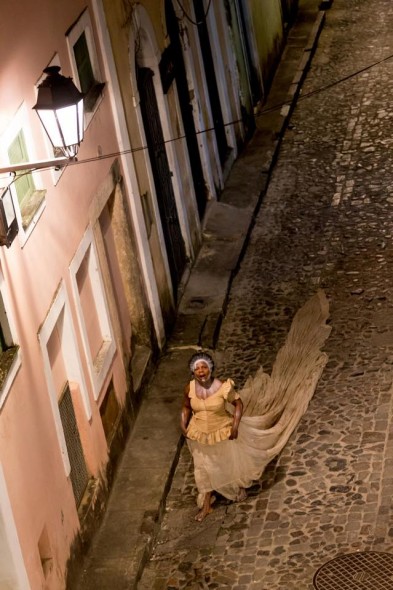
The spectator who acts
The stage and the audience, the actor and the public, inseparable while at the same time isolated, conditioning elements of theatrical experience, which, over time, generated numerous ways to configure this connection. Not every public is that one sitting in comfort, lights off, passively waiting for the performance to end. Not every public only watches. Many of the works presented at FIAC 2015 proposed a non-traditional spectator position, often out of the chair, others within stage space.
Deployed as a device in many of the works, the public acquires layers, complexity, and (why not?) dramaturgy itself in performances that required corporal movement, the need to speak and, finally, action. The boundary between the actor and the spectator was sometimes strained, experiences of great interest to our study here, since these proposals have shown that the possibilities of this ontological relationship are by no means exhausted.
A recurring scenic situation in the festival’s presentations revolved around a reduced public and small scenes with the audience. However, the actor-public options we will speak about now relate to other approaches. For example, in the street presentations in the works that presented in a fixed location, Galeria Urbana Homo sem Cabeça (Lucas Valentim, Lucas Moreira and Isabela Silveira, Bahia) and História sob Rocha (Daniel Guerra, Bahia), it was possible to identify some audience modalities: 1) the public that was accompanying the festival and therefore followed to the programmed location, as you would if you were buying a ticket to a play in a theater; 2) a spectator en passant, a passerby who saw the scene the moment of his walking by – and who, in addition to being part of the “ambiance,” could pass several moments as a spectator as the “coming and going” – the movement of the piece – would have the passerby intersecting with the act several times; 3) and what we call the “background spectator”: the spectator who, watching from the front, actually becomes part of the scene, watching it from a kind o superimposed position – the scene of the public within the actor’s scene. The act of watching the first public watching the spectacle. A doubling up of perspective.
On the street, this layering of the public could be perceived by the physical distance between one group of people and another. A public that sees the other, which in turn sees the other, and so on, since, depending on the street, other publics could still be seen or envisioned: for example, local residents, who were up high in the buildings, watching from windows and seeing all at a distance, from beginning to end, from top to bottom, without an exact dimension of what it was about; as well as trade workers; habitues of the square; people in the cars passing by and all the local people who were not even passing by and neither a spontaneous audience, who just stopped to watch: rather they just were there at the time and looked when interested. “The expanded spectator.”
This public division was critically addressed in Ruína de Anjos (A outra companhia, Bahia) when the festival audience (who had tickets) received a VIP bracelet to put on their wrists and follow the actors through the Politeama neighborhood in two moments of audience privilege. First, when entering a gallery building, to pass through the gate railings, only “VIPs” had the security clearance; the rest of the public, who joined the group during the scenario (more people than those who had bracelets), watching from the outside. In a later scene, where there is the simulation of a rickety electric trio, the VIPs were inside the rope, the other spectators milling around outside it. After the realization that it would be necessary to limit the number of spectators who could enter the gallery, dramaturgy takes this condition as a possibility to question the hierarchical structures suffered by the public daily – from Carnival to the church. “You want to win a bracelet, brother?” – the pastor character in the gallery asks those who were on the other side. This thematization of the public, who then becomes a character in the performance, is what we will focus on now.
In the Ruína de Anjos performance, the public was constantly engaged in their role as an everyday public. The audience that follows the electric trio, the pastor, watching the street fighting, the jugglers at the traffic signal, the very public theater; those spectators were charged with possible typologies of a possible public, and the character-performers conversed with this “character-public” as an allegory included in the text. The public-character multiplies layers of critical reception when it turns you into a public that, ordinarily, you would not be.
In Orgia ou de como os corpos podem substituir as ideias (Teatro Kunyn, São Paulo), the public goes through two antagonistic operations. At first, it is treated as intimate acquaintances of the main character: in a neighborhood home all viewers are greeted as friends. There is wine to toast the friendship encounters, members of the public make food in the kitchen, the character says things like “remember that day, the people dancing …”. A fictionalization of intimacy is risked that on the day in which we participated, and all agreed on, including relating made-up stories to the character: The scene held an impromptu instance that allowed the public to say whatever it wanted to, even to invent memories. In the second phase, the public leaves with the protagonist who is traveling to another country, wandering the city streets to the Largo do Campo Grande. This public, which before was a “friend,” now using headphones, becomes a voyeur in relation to the protagonist, who now takes a considerable distance from the spectators, almost disappearing in perspective. The dialogues heard by earphone have a clandestine tone, are pornographic, obscene, and transform the viewer’s eyes into hidden cameras. You cannot see details of the actors’ faces, and interestingly, seeing the official voyeur audience, another audience focuses on who the people with the headphones are, and barely distinguish the actor’s scene taking place in the Largo from normal life. The public is more visible than the scene.
Inside the theater, even in their seats, the public had a role in Hamlet – Processo de revelação (Coletivo Irmãos Guimarães, Brasilia). With the audience light on and the spectator intervening whenever he or she wanted to and answering the actor’s questions on issues arising from the Shakespearean story, the spectator shares in the implementation/ development of the narrative. Somehow, the spectator takes over control of the performance – if the actor has lost it – and control of the performance’s duration. In the dance performance 6 modelos para jogar (Alex Cassal and Dani Lima, Rio de Janeiro) directed by Denise Stutz, the spectator is called upon to enter the stage while the dancers play, sing and drink beer in the audience. The portion of the audience seated on stage is assisted by those remaining in the audience, which changes the scenic cartography, and the stage/audience boundary is diluted, the whole space is one site to see and do. This, then, seems to be the most acute transformation of spatial characteristics signaled in the festival’s presentations, even though the boundaries between audience and dancers remains.
Going back to the street scene, História sob Rocha (Daniel Guerra, Bahia) can transcend boundaries. Called a “scenic event” by the artists involved, the performance creates an area of ”living together” in front of the Lacerda Elevator. Many objects are scattered over a wide area in order to interact with them and the music is manipulated live. The category of spectator hardly exists during the long hours of hard work, and all those who wish to remain “step into” the living space, where artists are not distinguished from spectators. The others are bystanders. The work has the temporal duration of living presence, not of a scenic presentation.
Were it not for Clean Room – 2nd Season (Juan Dominguez, Spain), História would be the production with the shortest distance between actor-spectator. The work of the Spanish artist cannot be seen by regular festival goers, as the only spectators allowed to participate were already involved in the process a month before the start of the festival. In a game of coordinates, these people shared a house (an unknown address) and their tasks for almost two months, counting with the time that extended beyond the end of the festival. What they experienced living there only they knew and saw. Juan Dominguez gave the name of “spectator” to this presence. Stage and the audience in the same space, actor and spectator in the same body, there is no gaze, or perspective from the outside directed at what is happening, but there is action. The artist’s inspiration comes from reality shows, but without the “to show,” without display. There is dramaturgy and there is reality, the action is of people acting and watching. The spectator went over to the other side, opposite to the characters of Krum (Companhia brasileira de teatro, Paraná).
Closing the festival, Krum provokes the audience (in the traditional staging of Italian theater) when positioning the characters as passive spectators of themselves. Sitting and waiting in chairs they watch the time pass. The fan turns weakly, the immobility of the life stories, the discontinuance. A row of empty chairs is positioned in front of the rows of audience seats. In the last scene, they all they sit and look at the empty stage, the house-stage where they all were congregated without leaving the site. To sit with the audience to watch your own life is a kind of renouncing, or resignation. The characters sit, look toward the front – a chair is left over. Who wants to be this spectator?
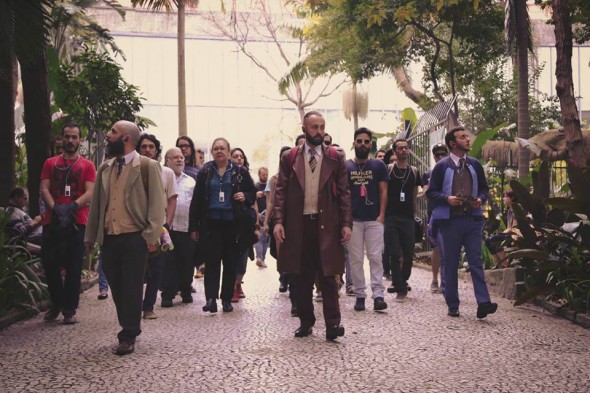
Mariana Barcelos, an actress, with an undergraduate degree in the Theory of Theater from UNIRIO (University of Rio de Janeiro) is now a student in the undergradute program in Social Sciences at IFCS-UFRJ (Institute de Filosofia e Ciências, Federal University at Rio de Janeiro.
Renan Ji holds a Doctorate in Comparative Literature from the Federal Fluminense University (Universidade Federal Fluminense/UFF). He is a regular contributor and collaborator to the Revista Questão de Crítica and a member of the juries that judge and award prizes for the Prêmio Questão de Crítica and the Prêmio Yan Michalski.
Translation notes:
[1] Trans. note. The (semi) restored colonial district of Salvador is called the Pelourinho, a word that refers to the large pole in the middle of a central square to which slaves were tied to be whipped or left tied to as punishment.
[2] Trans. note: “We for example/Nós por exemplo” refers to a song by Bahian musician and composer Gilberto Gil, bringing to mind the broader context of the tropicalist movement of the late ’60s and ’70s and Gil, Caetano Veloso, Gal Costa and Maria Bethânia, who in the mid ’70s were referred to as the “Doces Bárbaros” – the “Sweet Barbarians” but a term that functions in Portuguese to invert adjectives to give the sense of “fantastic delectables”. The four artists got together in 1976 for a series of shows that commemorated their respective careers, but that also served to project the singers – and Bahian culture – into the national culture, generally dominated by Rio or São Paulo. The festival also sees its mission in this light: to project Bahian culture while bringing the best of other Brazilian and international performance to the local scene.
[3] Trans. note: manguebeat: a musical and social movement, originating in the Northeastern city of Recife (mangue refers to the mangrove swamps that border the city’s river estuary). Noted for its mix of regional musical elements and its strong, and sometimes furious, rock beat.


